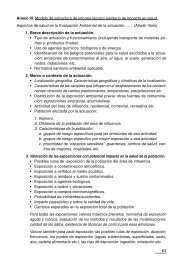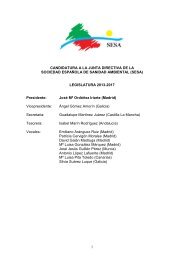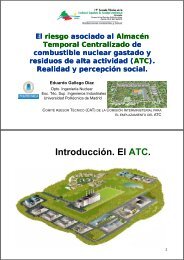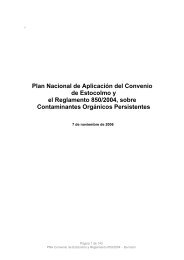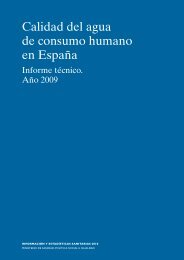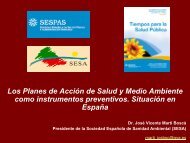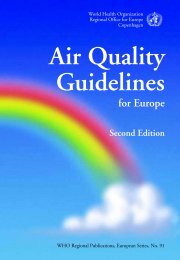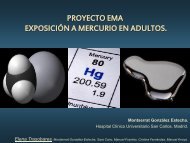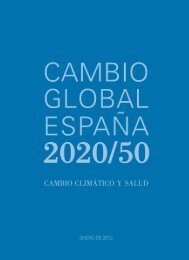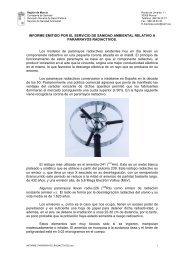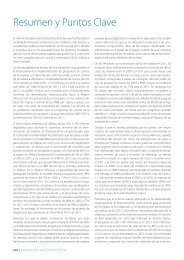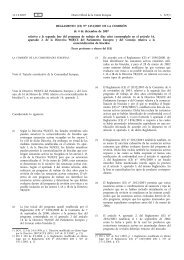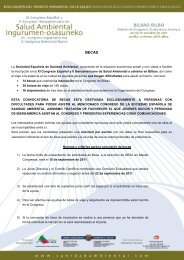ISEE 2011 Barcelona
ISEE 2011 Barcelona
ISEE 2011 Barcelona
You also want an ePaper? Increase the reach of your titles
YUMPU automatically turns print PDFs into web optimized ePapers that Google loves.
The Encompassing Face ofEnvironmental Epidemiology<strong>ISEE</strong> <strong>2011</strong> <strong>Barcelona</strong>More info: Mark Nieuwenhuijsen: mnieuwenhuijsen@creal.cat1
<strong>2011</strong> Annual Conference of the International Society for EnvironmentalEpidemiology in <strong>Barcelona</strong>, SpainDates –13 th Sept – 16 th Sept <strong>2011</strong>International Society for Environmental Epidemiology (<strong>ISEE</strong>)<strong>ISEE</strong> is an international organization with almost 1000 members from more than 60countries and regional chapters and local groups in Latin America and theCaribbean, the Mediterranean, Central and Eastern Europe, the Caucasus, SouthAsia, and East Asia. The International Society for Environmental Epidemiology(<strong>ISEE</strong>) provides a forum for the discussion of problems unique to the study ofhuman health and the environment. With membership open to environmentalepidemiologists and other scientists worldwide, <strong>ISEE</strong> provides a variety of forumsfor discussions, critical reviews, collaborations and education on issues ofenvironmental exposures and their human health effects. These include annualmeetings, newsletters, workshops and liaisons with academic, governmental, intergovernmental,non-profit and business institutions. Topics addressed by <strong>ISEE</strong>members include environmental exposures (e.g. air pollution, hazardous waste,metals, pesticides, radiation), health effects (e.g. cancer, cardiovascular disease,neurologic effects, reproductive effects), methodology (e.g. biomarkers, ecologicinvestigations, experimental design, exposure/dose assessment, meta-analysis, riskassessment, statistics), environment-gene interactions, and ethics and law.Centre de Recerca en Epidemiologia Ambiental (CREAL)The conference will be organized by faculty from the Centre of Research inEnvironmental Epidemiology (CREAL)(http://www.creal.info/), funded by theDepartments of Environment and Health of the Generalitat, the Government ofCatalonia and affiliated with the Municipal Institute of Medical Investigations (IMIM)(http://www.imim.cat/) and the University Pompeu Fabra (http://www.upf.es/) in<strong>Barcelona</strong>, Spain. CREAL is led by Professor Josep Maria Antó, and co-directorsProfessors Jordi Sunyer and Manolis Kogevinas. It has a further 10 seniorinvestigators and a total of around 70 staff. CREAL research is organized in threedifferent programmes: childhood health, cancer and respiratory diseases withstrong focus on exposure to water, air pollution, radiation and other environmentaland occupational exposures. CREAL scientists are leaders and steering committeemembers of numerous international collaborative research programs. CREAL givesalso scientific advice to national and international public health authorities andcollaborates in research applied to public health concerns. The proposedconference will coincide with the 5 th anniversary of CREAL.The conference Chair and co chair of the local organizing committee will beProfessors Mark J Nieuwenhuijsen and Manolis Kogevinas.2
Composition of the honorary CommitteeThe honorary committee of the meeting includes (proposed):Chair: Boi Ruiz i Garcia, Minister of Health, Generalitat1 Leire Pajín, Minister of health, Madrid2 Jose Navas, ISC III, Madrid3 Lluis Recoder i Miralles, Minister of Town and Country Planning and Sustainability,Generalitat4 Andreu Mas-Colell, Minister of Economy and Knowledge, Generalitat5 Jaume Raventos, DG Parc de Salut Mar6 Jose Juan Moreso, Rector Universitat Pompeu Fabra7 Manuela Soares, Director, DG Research-Environment8 Octavi Quitana Trias, Director Euratom9 Maria Neira, DG Public Health and Environment, WHO10 Jacqueline McGlade, ED European Environment AgencyComposition of Local Organizing Committee and Scientific ProgramCommitteeLocal Organizing Committee. The local organizing committee will include theconference chairs and others from the region:• Mark J Nieuwenhuijsen – CREAL, <strong>Barcelona</strong>• Manolis Kogevinas – CREAL, <strong>Barcelona</strong>• Jordi Sunyer – CREAL, <strong>Barcelona</strong>• Josep Maria Antó – CREAL, <strong>Barcelona</strong>• Jan-Paul Zock – CREAL, <strong>Barcelona</strong>• Cristina Villanueva – CREAL, <strong>Barcelona</strong>• Martine Vrijheid - CREAL, <strong>Barcelona</strong>• Elisabeth Cardis - CREAL, <strong>Barcelona</strong>• Bart Ostro, CREAL, <strong>Barcelona</strong>• Dr Tony Placencia - Director General of Public health, Government ofCatalonia• Joan Grimalt – CSIC, <strong>Barcelona</strong>• Teresa Moreno – CSIC, <strong>Barcelona</strong>• Xavier Querol – CSIC, <strong>Barcelona</strong>• Mar Viana – CSIC, <strong>Barcelona</strong>• Ferrán Ballester – CSISP, ValenciaScientific Program Committee. The scientific program committee members includesleaders of environmental epidemiology and members of the <strong>ISEE</strong> from the region,plus environmental epidemiologists from all regions of the world3
Chair: Juha Pekkanen, THL, Kupio, FinlandVice chair: Brenda Eskenazi, University of California, Berkeley• Gabriella Aggazotti, University of Modena, Italy• Dean Baker, University of California, Irvine (UCI), US• Roberto Bertolini – World Health Organization Regional Office for Europe,Geneva, Switserland• Ioan Bocsan, Regional Institute of Health, Cluj, Romania• Aaron Cohen, HEI• Mary Ward, NCI, Washington• Bert Brunekreef, IRAS, Utrecht, The Netherlands• Sylvaine Cordier, University of Rennes, INSERM, Rennes, France• Jeroen Douwes, Massey University, Wellington, New Zealand• Eric Lebret, RIVM, The Netherlands• Tony Fletcher, London School of Hygiene and Tropical Medicine, London, UK• Francesco Forastiere, Rome E Health Authority, Rome, Italy• Frank Gilliland – University of Southern California USC Keck School ofMedicine, US• Francine Kaufman, INSERM, France• Francine Laden, Harvard University, US• Barbara Hoffman, University of Duisberg-Essen, Essen, Germany• Philipe Grandjean, Harvard University, US• David Savitz, Mount Sinai, New York, US• How-Ran Guo, Medical College, National Cheng Kung UniversityTaiwan, Taiwan• Joachim Heinrich, Helmholtz Institute, Munich, Germany• Jane Heyworth, University of Western Australia, Perth, Australia• Irva Hertz-Picciotto – University of California, Davis, US• Michael Jerrett, University of California Berkeley, US• Klea Katsouyanni, University of Athens, Athens, Greece• Nino Kunzli – University of Basel, Switzerland• Sally Liu - University of Basel, Switzerland; University of WashingtonSeattle, US• Stephanie London, National Institute of Environmental Health Sciences, US• Matthew Longnecker, National Institute of Environmental Health Sciences,USA• Imane Jroundi, Casablanca, Morocco• Tony McMichael, National Centre for Epidemiology andPopulation, Canberra, Australia• Marie O´Neill, University of Michigan School of Public HealthMichigan, USA• Marina Pollan, ISCIII, Madrid• Jorn Olsen, Danish Epidemiology Science Centre, Denmark• Annette Peeters, Helmholtz Institute, Munich, Germany• Goran Pershagen, Karolinska Institute, Sweden• Neil Pearce, Massey University, Wellington, New Zealand• Silvia de Sanjosé, ICO, <strong>Barcelona</strong>• Tony Agudo, ICO, <strong>Barcelona</strong>• Beate Ritz, University of California (UCLA), Los Angeles, US• Isabelle Romieu – National Institute of Public Health, Mexico• John Samet, University of Southern California, US• Fernando Garcia-Benavides, UPF, <strong>Barcelona</strong>• Joel Schwartz, Harvard School of Public Health, Boston, US• Remy Slama, INSERM, Grenoble• Duncan Thomas, Keck School of Medicine University of Southern California,US4
• Mireille Toledano, Imperial College London, UK• Federica Perrera, Columbia University, New York, US• Dan Wartenberg, UMDNJ, New Jersey, US• Paolo Vineis, Imperial College London, UK• Afif Ben salah, Institut Pasteur- Tunis, TunisiaLocation and Conference SiteIn a privileged position on the north-eastern coast of the Iberian peninsula and theshores of the Mediterranean, <strong>Barcelona</strong> is the second largest city in Spain in bothsize and population. It is an important trading port and link between Spain, Europeand the rest of the world. It is also the capital of Catalonia, 1 of the 17 AutonomousCommunities that make up Spain.The capital of Catalonia is unequivocally a Mediterranean city, not only because ofits geographic location but also and above all because of its history, tradition andcultural influences. The documented history of the city dates back to the foundingof a Roman colony on its soil in the second century B.C. Modern <strong>Barcelona</strong>experienced spectacular growth and economic revival at the onset ofindustrialization during the second half of the 19th century. The 1888 World's Fairbecame a symbol of the capacity for hard work and the international outlookprojected by the city. Culture and the arts flourished in <strong>Barcelona</strong> and in all ofCatalonia; the splendour achieved by Catalonian modernism is one of the mostpatent displays.The venue is the the Palau de Congresos de <strong>Barcelona</strong> in Plaza d´España. Thelocation is well connected by walking, bus or metro with the lively areas around theRamblas and the famous Modernista neighborhoods influenced by Gaudi and otherarchitects of the late 1800-ies.Theme and Specific Conference Topics<strong>Barcelona</strong> is one of the major centres of research, technology, trade, and tourism inthe Mediterranean area. It is the historic capital of the Catalonia region, which is ahot spot of the Spanish economy and location of the largest Mediterranean port. Asa consequence of the high level of industrialization and the relatively short timeperiod since the rebirth of democracy, environmental health problems aresubstantial in the region and the state, as they are in many Mediterraneancountries. Air, water, and soil pollution are a legacy of the past and currenteconomy. The city of <strong>Barcelona</strong> has one of the highest population densities inEurope, and traffic substantially adds to the environmental pressures on air qualityand noise. <strong>Barcelona</strong> has a long tradition of urbanism that makes it an importantreference point in urban design and town planning. Its modern urban developmentis based on the extension plan (Example) created by Ildefons Cerdà, an engineeringand utopian socialist who took into account public health concerns. When thegovernment of the time finally gave in to public pressure and allowed <strong>Barcelona</strong>'scity walls to be torn down, he realized the need to plan the city's expansion so thatthe new extension would become an efficient and livable place, unlike thecongested, epidemic-prone old town within the walls.The tension between intense urban development, economic prosperity, globaltrade, and environmental degradation is coupled with visionary investments of theCatalonia region into research, resulting in numerous research activities inenvironmental epidemiology and environmental health sciences. The environmentalproblems of the area are a model of problems encountered in many Mediterranean5
egions and the world. These features will thus serve as an inspiration to theconference themes.The overall conference theme will be “The encompassing face of environmentalepidemiology”The themes include:Sustainable transport and health: Impact of transport on health and approaches toreduce health impactsImpact of climate change: from water scarcity to Saharan dust episodesEarly exposure - later life: in utero and early life exposures and effects in later lifeNew methods and technologiesThe conference will also encourage symposia and abstracts on topics that havebeen of long standing interest to <strong>ISEE</strong> members and that are typically representedin the annual conferences. Studies of air pollution, pesticides, water quality,children’s environmental health, and epidemiological methods are likely topics.Topics of particular relevance to participants from the Mediterranean region will beencouraged. The keynote lectures will address the conferences themes at earlymorning sessions. Furthermore, there will be sessions for cutting edge studies inenvironmental epidemiology throughout the conference. Oral presentations in thissession will cut across the various areas of environmental epidemiology and areselected because e.g. they provide significant new insights, use innovativemethodology, and are of great importance because of study size. Furthermore therewill be sessions for review and educational presentations, which are targetedtowards the younger participants but may also be of interest to senior participants.BudgetAround 800 delegates are expected to attend the conference. The current budgetfor the meeting is 500,000 euros, with an estimated income of 400,000 euros fromregistrations and 100,000 euros through sponsorship.6



